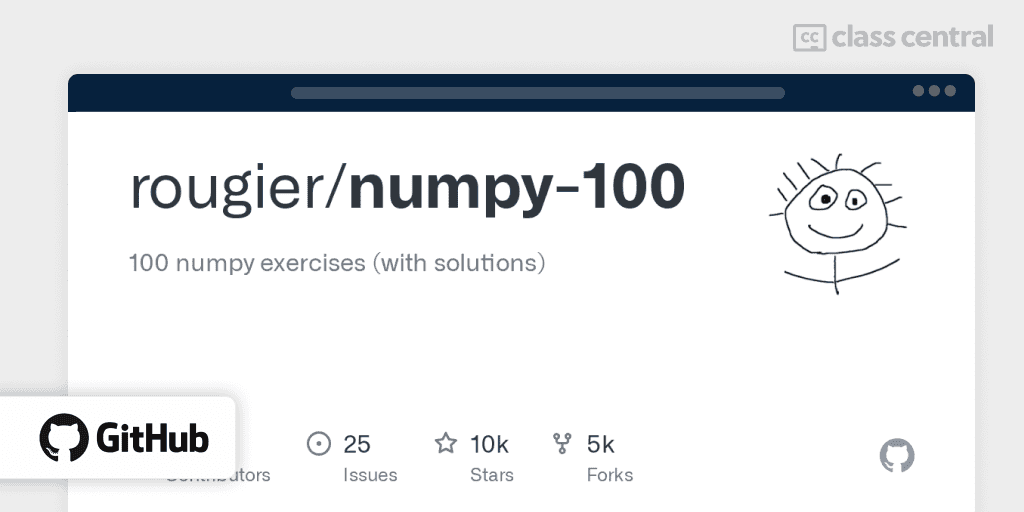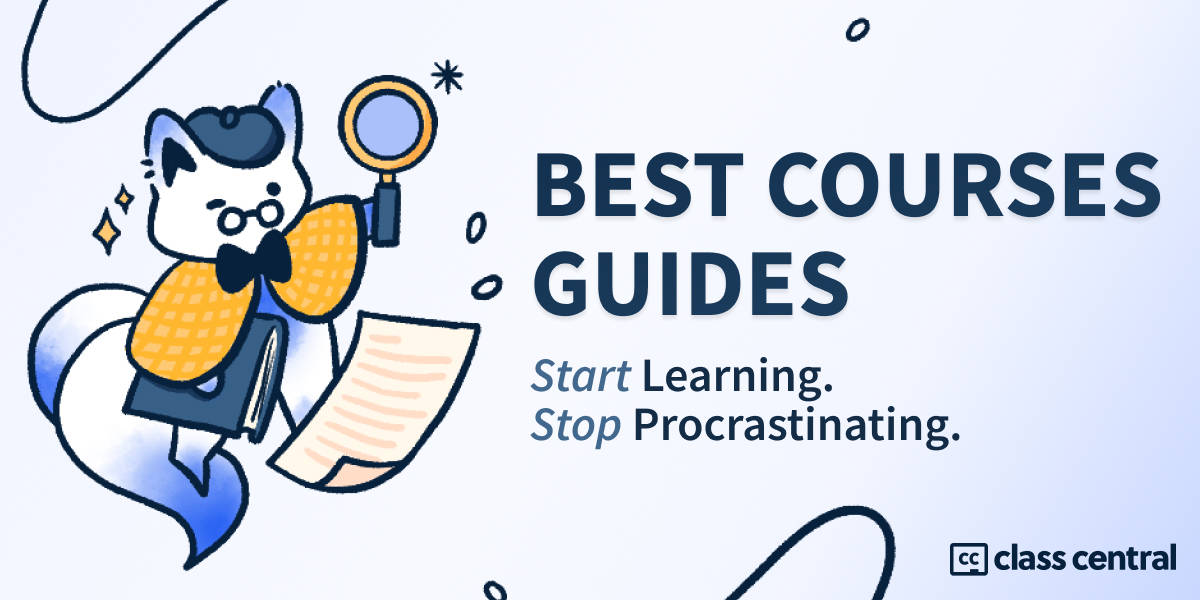10 Best NumPy Courses for 2025: Efficient Scientific Computing
Boost Your Data Science Skills with These Top-Rated NumPy Courses

NumPy is the most fundamental package in Python’s scientific computing world. Its popularity lies in its ability to handle and operate on arrays and matrices of any size, whether they contain a handful of elements or millions of them. From machine learning and artificial intelligence to physics and engineering, NumPy is the go-to library for anyone who works with numbers — at least for two thirds of Python developers!
And who said that simplicity is a trade off for performance? NumPy is blazingly fast and versatile, while also being easy to learn. And with the right courses, you’ll learn it even quicker. I’ve compiled a list of the best courses to learn NumPy in this Best Courses Guide. So if you’re serious about crunching numbers, look forward to my top picks.
Click on the shortcuts for more details:
- Top Picks
- Why NumPy is the Fundamental Package for Scientific Computing in Python
- Courses Overview
- Why You Should Trust Us
- Best Courses Guides Methodology
Here are our top picks
Click to skip to the course details:
Why NumPy is the Fundamental Package for Scientific Computing in Python
NumPy is an open-source Python library widely known for its efficient handling of complex, mathematical operations on large, multidimensional arrays (called ndarrays). To understand why NumPy is so popular, we must first contrast NumPy arrays to Python’s native lists.
Python wasn’t designed with numerical computing in mind. However, what was designed in mind was simplicity and readability. Funnily enough, it was this design decision that drove more and more scientists and engineers to adopt the Python language for their computational work, even though it wasn’t as fast as other harder-to-learn languages. Instead of looking for another alternative, scientists and engineers did what they do best and adapted the language to their needs, resulting in the development of many scientific frameworks and libraries to overcome Python’s inherent sluggishness.
Thus, NumPy was born. By utilizing fixed types, no type checking when iterating through objects, utilization of contiguous memory, effective cache utilization, as well as other optimization techniques, NumPy is now much faster than the standard Python list with a magnitude of 5 to 100 times! And when paired with an efficient Python implementation like Cython, it can even reach speeds up to 1250 times faster!
Taken from Lesson 3 – Numerical Computing with Numpy | Jovian.
Though that wasn’t the only thing NumPy brought to the table. NumPy also provides a wealth of functions that enable complex operations on arrays with just a few lines of code, including mathematical, logical, shape manipulation, discrete Fourier transforms, basic linear algebra, basic statistical operations, random simulation, and much, much more.
All of these reasons combined brought NumPy the versatility and speed needed to become the fundamental package for all scientific computing in Python, and it did. With an astounding 64% of all Python developers using NumPy for data-related tasks, it’s hard to say that it isn’t one of the most widely used Python packages. In fact, it even serves as the base for many other major data science libraries in Python, such as pandas (which is only 5% less popular than NumPy)!
One hidden benefit that brings is that NumPy seamlessly integrates with most other Python libraries as well, like SciPy, TensorFlow, scikit-learn and Matplotlib. Together, these libraries provide a complete data science and scientific computing environment, making it easy for anyone to analyze, visualize, and manipulate data all within a single Python environment!
Hence, whether you’re a data scientist, machine learning engineer, or just someone who needs to crunch a bunch of numbers in a short amount of time, NumPy is definitely worth learning.
Courses Overview
- Every course in this guide assumes you have basic familiarity with Python
- The most represented provider is YouTube, followed by other independents
- All the courses, with the exception of three, are suitable for NumPy beginners.
Best Comprehensive Free Course for Beginners (Ben Gorman)
This comprehensive course doesn’t merely teach you the fundamentals of NumPy in a short amount of time, it also challenges you with fun and interesting Jupyter notebook exercises (about 18 in total) to help you practice what you’ve learned and really understand what’s going on behind the scenes in NumPy! Oh, and did I mention that it’s free?
In Python NumPy For Your Grandma, Ben Gorman covers what you’d want to know about NumPy to solve complex numerical problems, including simple topics like array creation, transformations, and random sampling, to more complicated ones like indexing and broadcasting.
What you’ll learn:
- Why NumPy? Understand the motivation behind NumPy arrays and how they differ from regular Python lists
- Basics of NumPy arrays: creation, indexing, and mathematical operations
- Intermediate concepts: broadcasting, reshape(), and Boolean indexing
- Key functions: where(), all(), and any() to check conditions, and concatenate and sorting to sort and find unique values
- Advanced techniques: array indexing intricacies, as_strided(), and einsum().
If you prefer reading, there’s a written version of this course. You can find the full course syllabus on Reddit. An incomplete version is also freely available on Udemy.
Additionally, Ben Gorman has a lot of other well-made courses on his YouTube channel, like this one on Pandas and this other one on Neural Networks.
| Provider | YouTube |
| Instructor | Ben Gorman |
| Level | Beginner |
| Workload | 2–3 hours |
| Views | 26K |
| Rating | 4.7 /5.0 (234 Udemy ratings) |
| Assessments | 18 challenge videos |
| Certificate | None |
Best Concise Free Tutorial for Beginners (freeCodeCamp)
In Keith Galli’s Python NumPy Tutorial for Beginners, you’ll get a thorough exploration of the underlying principles behind NumPy’s functionality in just under an hour! You’ll also dive into the basics of creating arrays and quickly progress to more advanced concepts such as indexing, math, statistics, and reshaping.
In this easy-to-understand free tutorial for beginners, you’ll learn:
- Differences between NumPy arrays and Python lists
- Array creation, modification, and initialization techniques
- Mathematical operations: arithmetic, trigonometry, linear algebra, and statistics
- Array reorganization: reshaping, vertical/horizontal stacking
- Advanced indexing and Boolean masking
- Loading data from files for handling large datasets.
The content of the course is delivered in two parts: one devoted to teaching the theory and applications of NumPy using slides, while the other dives into using NumPy with on-screen demos.
If you like this course, you should:
- Check Keith Galli’s YouTube channel, where there are educational videos on Computer Science, Programming, Board Games, and more!
- freeCodeCamp offers many other courses on various programming languages on their YouTube channel as well as on their website.
| Institution | freeCodeCamp |
| Provider | YouTube |
| Instructor | Keith Galli |
| Level | Beginner |
| Workload | 1 hour |
| Views | 1.4M |
| Likes | 36K |
| Certificate | None |
Best Free Intermediate Course on NumPy Vectorization (Nicolas P. Rougier)
From Python to Numpy by Nicolas P. Rougier takes a different approach to NumPy from what other courses might take, teaching you techniques that you won’t find in most books. It focuses on using NumPy as a tool for vectorization, rather than as an object-oriented or procedural one. Many code examples and exercises will be provided to help you reshape your approach to many common problems.
Though this free course is a bit outdated (v1.12.0 vs v1.24.0 at the time of writing), around 99% of the code will still work.
To take this course, you should have an intermediate level of proficiency in Python and ideally a beginner level understanding of NumPy.
What you’ll learn:
- Fundamentals of vectorization and its advantages over loops
- Efficient use of NumPy ndarrays (n-dimensional arrays) over Python lists
- Identifying and solving vectorizable problems
- Techniques for uniform, temporal, and spatial vectorization
- Customizing NumPy for specific needs using TypedList and subclassing (GPUData)
- Exploring alternatives to NumPy within Python and external libraries.
Nicolas P. Rougier is a full-time research scientist at Inria, a French national institute for research in computer science and control. He has more than 15 years of experience using Python and more than 10 years of experience using NumPy for neuroscience modeling, machine learning, and advanced visualization with OpenGL. He teaches Python, NumPy, and scientific visualization at the University of Bordeaux and in various conferences and schools worldwide, including SciPy and EuroScipy.
| Institution | National Institute for Research in Digital Science and Technology (Inria) |
| Website | labri.fr |
| Author | Nicolas P. Rougier |
| Level | Intermediate |
| Workload | N/A |
| Exercises | Example codes and exercises with solutions |
| Certificate | None |
Best Free Series of Hands-on Tutorials in Lecture Format (Alex Chabot-Leclerc)
Presented by Alex Chabot-Leclerc at the SciPy 2019 Conference, Introduction to Numerical Computing with NumPy teaches students the basics of NumPy (with a sprinkle of matplotlib) through slide presentations, hands-on demonstrations, and exercises. The exercises include analyzing the daily performance of a company’s stock, getting statistical insights from wind data, smoothing an image by averaging neighboring pixels, and plotting an image — pretty fascinating if you ask me.
Hence, by the end of this free course you have enough knowledge of NumPy and matplotlib to undertake any numerically intensive project.
Also, if you want to follow along, you can find the tutorial materials here.
What you’ll learn:
- Fundamentals of NumPy and how ndarrays are represented in memory
- Creating and manipulating one and two-dimensional arrays
- Techniques for slicing arrays without modifying the original
- Image blurring using pixel averaging
- Fancy indexing (yes, that’s what it’s called), including indexing by value and Boolean masking
- Common mathematical functions like sum, product, min, max, and peak-to-peak.
Alex is the Vice President of Digital Transformation Solutions. He has taught the scientific Python stack and machine learning to hundreds of scientists, engineers, and analysts at the world’s largest corporations and national laboratories.
| Channel | Enthought |
| Provider | YouTube |
| Instructor | Alex Chabot-Leclerc |
| Level | Beginner |
| Workload | 2–3 hours |
| Views | 210K |
| Likes | 4.8K |
| Exercises | Yes, provided on GitHub |
| Certificate | None |
Best for Data Scientists and Analysts (DataCamp)
DataCamp’s Introduction to NumPy paid course with free trial takes you on a tour of NumPy by working with three real-world datasets: the New York City’s tree census, store sales data, and Monet paintings image data. Thus, anyone who takes this course will experience what it’s like to use NumPy (especially) as a data scientist or analyst — making this course quite practical.
By the end, you’ll understand why NumPy is so efficient, use broadcasting and vectorization to make your NumPy code even faster, and understand why array alterations are essential tools for machine learning.
What you’ll learn:
- Creation and manipulation of NumPy ndarrays for efficient data handling
- Advanced data wrangling techniques: slicing, filtering, and sorting arrays
- Principles of dimension compatibility and array mathematics
- Vectorized operations and broadcasting logic
- Array transformations using image data, including flipping, transposing, and stacking.
If you have a valid university email and have signed up for the GitHub student pack, you can get a 3 months free trial from DataCamp.
| Provider | DataCamp |
| Instructors | Izzy Weber, James Chapman, Amy Peterson |
| Level | Beginner |
| Workload | 4 hours |
| Enrollments | 35K |
| Rating | 4.7 (56) |
| Exercises | Quizzes and Interactive coding exercises |
| Certificate | Paid |
Best Short Course to Drill in the Foundations (LinkedIn Learning)
This NumPy Essential Training series on LinkedIn Learning will help strengthen your NumPy foundations.
You’ll learn how to work with ndarrays, NumPy’s fundamental data structure, with functions and operations such as indexing, slicing, broadcasting, and more. So, if you are mainly learning NumPy for numerical and statistical computing, this course has you covered!
No knowledge of NumPy is required to take this course.
What you’ll learn:
- Benefits of using NumPy and Jupyter Notebooks over Python lists and .py files
- Creating and manipulating different types of NumPy arrays
- Advanced array manipulation: adding, removing, sorting, reshaping, indexing, and slicing
- Performing operations on multiple arrays using broadcasting
- Aggregate functions for statistical analysis: sums and averages
- Reversing arrays for comprehensive data handling.
If you like this course, you should take the second part where the capabilities of NumPy for plotting graphs with matplotlib are analyzed.
Terezija Semenski has been a mathematician and software developer for over a decade, having led a QA team on educational, financial, and banking app development projects and before that, worked in the education sector teaching IT and Mathematics. She currently works as a freelance educator and software developer.
| Provider | LinkedIn Learning |
| Instructor | Terezija Semenski |
| Level | Intermediate |
| Workload | 1–2 hours |
| Enrollments | 17K |
| Rating | 4.7 / 5.0 (563) |
| Exercises | One quiz per chapter |
| Certificate | Paid |
Best Free NumPy Course for STEM Students (Luke Polson)
So you’re learning NumPy for numerical or scientific computing? Then this course is just for you!
You’ll start learning NumPy from scratch in this free NumPy tutorial, before gradually climbing your way up to more advanced concepts. Through Jupyter Notebooks, you’ll be guided through the ins and outs of NumPy.
You should have some experience with Python before taking this course.
What you’ll learn:
- Basic operations with NumPy arrays: creation, indexing, slicing, and vectorization
- Performing statistical analyses, such as calculating mean and standard deviation
- Using Matplotlib to plot derivatives and integrals
- Matrix operations, including solving linear equations and finding eigenvalues/eigenvectors
- Importing CSV datasets into NumPy for data analysis.
Luke is currently a PhD student at the University of British Columbia studying Medical Physics. He runs a YouTube channel with the aim of making Python education available to all. He also has a Udemy course called Python STEM Essentials.
| Channel | Mr. P Solver |
| Provider | YouTube |
| Instructor | Luke Polson |
| Level | Beginner |
| Workload | 1–2 hours |
| Views | 149K |
| Likes | 4.6K |
| Certificate | None |
Also Great Numpy Course with Statistics (Codecademy)
Learn Statistics with NumPy is a great introductory course to both NumPy and Statistics to anyone who already knows some Python.
In this course, you’ll learn the basics of analyzing data. By the end, you’ll be able to do basic analysis of a dataset and understand how we can use statistics to come to conclusions about data.
What you’ll learn:
- Introduction to NumPy: creating and manipulating arrays for numerical data
- Performing mathematical operations and linear algebra with NumPy
- Basic and advanced statistical concepts: mean, median, standard deviation, and statistical distributions
- Hypothesis testing and statistical analysis using NumPy.
| Provider | Codecademy |
| Level | Intermediate |
| Workload | 5 hours |
| Enrollments | 19K |
| Rating | None |
| Exercises | Project and quizzes (for paying learners) |
| Certificate | Paid |
Best Free Advanced NumPy Course on Patterns for Scientific Computing (Juan Nunuz-Iglesias)
Do you already know some NumPy (perhaps by taking the fourth course in this guide) and want to level up your knowledge? Then, this course is for you!
In Advanced NumPy, Juan Nunuz-Iglesias teaches you advanced NumPy patterns for scientific computing. To simulate the kind of complex data you’ll most likely work with, he’ll solve questions regarding gene expression and RNA-seq (don’t worry, you’ll learn how to read them at the start of this course). Through a Jupyter Notebook hands-on tutorial, you’ll cover broadcasting rules, strides / stride tricks, advanced indexing, and more!
The prerequisites for this course are Python and basic NumPy / array computing.
What you’ll learn:
- Internal structure of NumPy arrays: shape, dtype, and strides
- Memory efficiency techniques in NumPy, such as strides and views
- Broadcasting rules for performing operations on arrays of different shapes
- Sliding window techniques for filtering and analyzing data subsets
- Advanced indexing methods for selecting and manipulating array subsets.
Juan Nunez-Iglesias is a Research Fellow and CZI Imaging Software Fellow at Monash University in Melbourne, Australia. He is a core developer of scikit-image and has taught scientific Python at SciPy, EuroSciPy, the G-Node Summer School, and at other workshops. He is the co-author of the O’Reilly title “Elegant SciPy”.
| Channel | Enthought |
| Provider | YouTube |
| Instructor | Juan Nunuz-Iglesias |
| Level | Advanced |
| Workload | 2–3 hours |
| Views | 34K |
| Likes | 695 |
| Material | GitHub repo |
| Certificate | None |
Best Free Collection of Exercises for Practicing NumPy (Nicolas P. Rougier)
100 NumPy exercises is a collection of NumPy problems from all over the Internet, along with some created and thrown in by the author, Nicolas P. Rougier.
Doing is the best way of learning. Hence, this course will help you brush up your NumPy skills into tip-top shape by doing a hundred exercises that gradually increase in difficulty. You’ll have hints to guide if you get stuck, and once you’re done, you can check with the solution.
This course is suitable for all levels of programmers,from beginners to advanced.
*Readers with eagle eyes may recognize that the author of this course is in fact the same as the one in the third course in this guide!
The exercises are organized into the following categories:
- Basic NumPy operations: Importing NumPy, creating basic arrays and matrices, finding memory size, accessing documentation, basic indexing, and mathematical operations (Exercises 1-17).
- Array manipulation: Creating specific arrays and matrices, reversing vectors, random values, min/max, mean, creating borders, normalization, custom data types, and matrix multiplication (Exercises 18-25).
- Array operations and expressions: Evaluating expressions, legal expressions, rounding, common values, ignoring warnings, and date operations (Exercises 26-34).
- Advanced array manipulation: Creating more complex arrays, working with generators, sorting, summing, equality checks, immutability, and coordinate transformations (Exercises 35-45).
- Structured arrays: Creating and working with structured arrays, computing distances, and custom array classes (Exercises 46-54).
- File I/O and iteration: Reading files, enumerating NumPy arrays, generating Gaussian-like arrays, and working with sliding windows (Exercises 55-59).
- Array math and comparisons: Matrix rank, most frequent values, contiguous blocks, and symmetrical 2D arrays (Exercises 60-70).
- Array operations and functions: Summing products, block-sums, Game of Life, and extracting largest values (Exercises 71-80).
- Array reshaping and subsetting: Creating specific arrays, matrix binary representation, and extracting unique rows (Exercises 81-90).
- Advanced NumPy functions: Record arrays, power calculations, einsum, sampling, multinomial draws, and bootstrapped confidence intervals (Exercises 91-100).
| Provider | GitHub |
| Instructor | Nicolas P. Rougier |
| Level | None |
| Workload | N/A |
| Stars | 10K |
| Certificate | None |
Why You Should Trust Us
Class Central, a Tripadvisor for online education, has helped 60 million learners find their next course. We’ve been combing through online education for more than a decade to aggregate a catalog of 200,000 online courses and 200,000 reviews written by our users. And we’re online learners ourselves: combined, the Class Central team has completed over 400 online courses, including online degrees.
Best Courses Guides Methodology
I built this ranking following the now tried-and-tested methodology used in previous Best Courses Guides (you can find them all here). It involves a three-step process:
- Research: I started by leveraging Class Central’s database. Then, I made a preliminary selection of over 480 NumPy courses by rating, reviews, and bookmarks.
- Evaluate: I read through reviews on Class Central, Reddit, and course providers to understand what other learners thought about each course and combined it with my own experience as a learner.
- Select: Well-made courses were picked if they presented valuable and engaging content. They have to fit in a set of criteria: comprehensive curriculum, affordability, release date, ratings and enrollments.
Ultimately, I used a combination of data and my own judgment to make these picks. I’m confident these recommendations will be a reliable way to learn about NumPy.
Fabio revised the research and the latest version of this article.

Elham Nazif




















Jim
@Elham, we’re in agreement that “Doing is the best way of learning.” So thanks for including your #10 pick, because the longest course in this Guide is merely 5 hours and some courses are passive (without any independent exercises). I also appreciate your explanations about why I should take each course, especially those noting certain considerations.
Jim
@Fabio numpy 2.0.0 is a major release, and its Release Notes are at https://numpy.org/doc/stable/release/2.0.0-notes.html